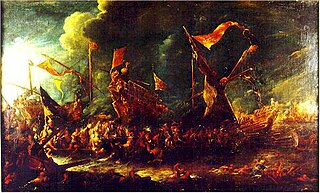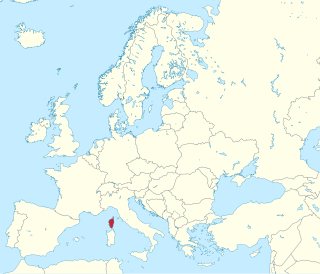Related Research Articles

Occhiali was an Italian privateer and admiral who served as the commander of the Regency of Algiers and Grand Admiral of the Ottoman fleet.

The action of 3 October 1624 was a naval engagement that took place near San Pietro Island, Sardinia, during the war against the Barbary corsairs. A squadron of galleys from the Spain, Grand Duchy of Tuscany and Papal States under Diego Pimentel engaged a squadron of six Algerian ships under Azan Calafate. The Algerians were defeated, their flagship was destroyed, and four ships were captured. Also, the Christian slaves they owned were freed.
The raid on La Goulette of 1615 was a naval attack by Spanish Ensign Francisco de Rivera on La Goulette, the main port of Ottoman Tunisia. After chasing Barbary pirates from Sicily to La Goulette, Rivera entered their harbor and captured several ships before escaping.

The Battle of Cape Celidonia took place on 14 July 1616 during the Ottoman–Habsburg struggle for the control of the Mediterranean. During its course, a small Spanish fleet owned by Viceroy of Naples Pedro Téllez-Girón, Duke of Osuna, under the command of Francisco de Rivera, was attacked by an Ottoman fleet that vastly outnumbered it while cruising off Cyprus. Despite this, the Spanish ships, mostly galleons, managed to repel the Ottomans, whose fleet consisted mainly of galleys, inflicting heavy losses.

The Battle of Cape Corvo was a naval engagement of the Ottoman–Habsburg wars fought as part of the struggle for the control of the Mediterranean. It took place in August 1613 near the island of Samos when a Spanish squadron from Sicily, under Admiral Ottavio d'Aragona, engaged an Ottoman fleet led by Sinari Pasha. The Spanish were victorious and captured seven galleys and about 600 prisoners, among them the Bey of Alexandria and another 60 important Ottoman nobles.

The Raid on Żejtun, also known as The Last Attack, was the last major attack made by the Ottoman Empire against Hospitaller-ruled Malta. The attack took place in July 1614, when raiders pillaged the town of Żejtun and the surrounding area before being beaten back to their ships by the Order's cavalry and by the inhabitants of the south-eastern towns and villages.

The Battle of Girolata was a naval action fought between Genoese, Spanish, and Ottoman ships on 15 June 1540 in the Gulf of Girolata, on the west coast of the island of Corsica, amidst the war between Charles V of Spain and Suleiman the Magnificent. A Spanish squadron of 21 galleys led by the Genoese Gianettino Doria and the Spaniard Berenguer de Requesens surprised an Ottoman squadron of 11 galleys, anchored at Girolata, led by the Ottoman admiral Dragut, whom the commander of the Ottoman Navy, Hayreddin Barbarossa, had committed to raid the Italian coast after his victories in the Adriatic Sea the year before. As the crews of the Ottoman warships were ashore, distributing the booty from recent raids, the Spanish-Genoese fleet easily overtook them, taking all 11 Ottoman galleys and making 1,200 prisoners, among them Dragut, who was carried to Genoa and put, together with his captains, to row in Andrea Doria's galleys.

The Raid on Constantinople of 1616 was a Spanish raid on Constantinople, the capital city of the Ottoman Empire. It was performed by Ottavio d'Aragona on the orders of Viceroy of Naples Pedro Téllez-Girón, Duke of Osuna.
The Battle of Ragusa was a naval engagement in 1617 between Francisco de Rivera from the Spanish Viceroyalty of Naples and Lorenzo Venier of the Republic of Venice. It resulted in a Spanish and Neapolitan victory.
Ottavio d'Aragona Taglivia (1565-1623) was a Sicilian nobleman in the service of the Hispanic Monarchy. He served under Viceroy of Naples and Sicily Pedro Téllez-Girón, Duke of Osuna as a highly successful naval commander.
Francisco de Rivera y Medina (1582–1646) was a Spanish naval commander. He had a successful career under Pedro Téllez-Girón, Duke of Osuna, acheving international fame for his victory over a vastly larger Ottoman fleet in the Battle of Cape Celidonia.
The raid on La Goulette of 1612 was a naval attack by Spanish captain Antonio Pimentel over La Goulette, the main port of Ottoman Tunisia. The raid destroyed a local fleet of western ships built by French privateer Zymen Danseker, who had planned to use it to spread Barbary pirate activity to the Spanish territories in America.
The raid on La Goulette of 1617 was a naval attack by Sicilian-Spanish captain Ottavio d'Aragona on La Goulette, the port of Ottoman Tunisia, where he destroyed the fleet in port in response to acts of local Barbary pirates.
The raid on the Kerkennah Islands of 1611 was a naval attack by Spanish commander Álvaro de Bazán y Benavides against the Kerkennah Islands, in Ottoman Tunisia. It resulted in a victory of the Spanish and its Italian allies over the local Ottomans and Barbary corsairs.
The Ottoman expedition to Messina in 1613 was an attempt by the Ottoman Empire to deliver a disguised attack in the port of Messina, in the Spanish viceroyalty of Sicily. Due to the spywork of Viceroy Pedro Téllez-Girón, Duke of Osuna, the expedition was discovered and its members were captured or killed almost in their totality.
The Battle of the Gulf of Tunis was a naval battle between a Spanish and Maltese galley fleet, commanded by Álvaro de Bazán y Benavides, Marquis of Santa Cruz, and a Barbary corsair flotilla captained by Ali Arraez Rabazin.
The Battle of the Dalmatian Coast of 1624 was a naval battle between a Spanish, Genoese and Maltese fleet captained by Álvaro de Bazán y Benavides, Marquis of Santa Cruz and a Barbary corsair fleet from Tunis and Algiers, originally pursued by him before the previous Battle of the Gulf of Tunis. It resulted in a Christian victory.
The Battle of Chios of 1621 was a naval battle between a Spanish and Italian fleet and an Ottoman-Barbary fleet near the island of Chios. It concluded with a Christian victory.
The Battle of Palermo of 1624 was a naval battle between Hispano-Maltese fleet led by Álvaro de Bazán y Benavides and a Barbary corsair fleet from Tunisia and Algiers.
The attack on Sousse was launched by a joint Christian armada in 1619 against the Tunisian city of Sousse. The attack ended in Fiasco for the Christians.
References
- 1 2 3 4 5 Bunes Ibarra (1989).
- ↑ Fernández Duro (1885), p. 384.
- 1 2 3 Fernández Duro (1885), p. 385.
- 1 2 3 4 Fernández Duro (1885), p. 386.
- 1 2 3 4 5 Fernández Duro (1885), p. 387.
- ↑ Fernández Duro (1885), p. 389-390.
- ↑ Fernández Duro (1885), p. 387-388.
- ↑ Fernández Duro (1885), p. 389.
- 1 2 Fernández Duro (1885), p. 390.